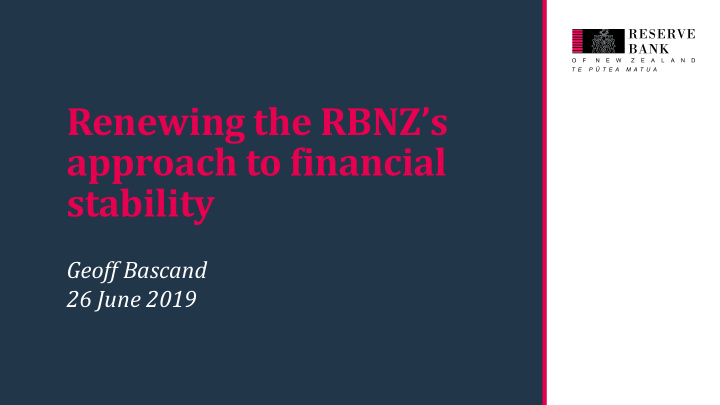



Renewing the RBNZ’s approach to financial stability Geoff Bascand 26 June 2019
Today • Why financial stability is important • The Reserve Bank’s role • The Reserve Bank’s approach to financial stability and the outlook • How the different parts of our financial stability regime fit together 2
Why we regulate and supervise • Financial stability is important to all New Zealanders • Savings and investment • Payment systems • Insurance • Risks • International and domestic • Structural and cyclical • Old and new • Market failures • Information asymmetries • Moral hazard 3
NZ’s finance sector Size of financial sectors by total assets (March 2019) 4
NZ’s finance sector Compared with OECD peers (percentile indicators relative to GDP) Source: The World Bank, Bank for International Settlements. Note: Data ranges from 2015 to 2018. 5
Reserve Bank’s role • The Reserve Bank is a full service central bank • With responsibility for financial stability • We work with other agencies on cross-cutting issues • FMA: – Joint-oversight of FMIs – Culture and Conduct review – NZX review 2029 • Council of Financial Regulators 6
Maintaining financial stability Identify and monitor risks; support effective self and market discipline Establish rigorous baseline requirements, and adapt as necessary Minimise the costs of institutional distress or failure 7
Financial stability approach • The three pillars remain relevant • Market discipline • Self discipline • Regulatory discipline • Recalibrating regulatory discipline • We are reviewing key elements of the regulatory pillar • Our supervision is becoming more intensive • Comprehensive • our tools and approaches are complementary 8
Regulatory toolkit Crisis Management Crisis Prevention Purpose Relevant tools Impact on financial system resilience Impact on wider economy More resilient households and banks Macroprudential policy Borrower restrictions reduce potential severity of an economic (LVRs) downturn Reduce risk that the Reduced losses in a severe economic Supervision, oversight and disclosure financial system amplifies a downturn severe economic downturn Lowers incentives on banks to Capital and liquidity deleverage in a downturn; supports instruments higher credit supply and economic (CCyB/SCR) activity Capital buffers Prudential policy Banks remain solvent through the Maintains market confidence Liquidity policy Maintain baseline resilience economic cycle and lowers risk of sudden increases in of the financial system funding costs for households, Governance and local businesses and the economy incorporation Collateral standards Banks remain functioning parts Maintains availability of credit and Manage and limit impact of Outsourcing of financial system banking services necessary for distress or failure economic activity Open Bank Resolution Mitigates costs for creditors 1 and taxpayers Minimum capital Losses absorbed first by shareholders 1 The government has announced its ‘in - principle’ decision to introduce deposit insurance. 9
Supervision – increased vigilance • Supervision is complementary to regulatory discipline • Key role in monitoring, enhancing, managing • Verifying and enforcing requirements • Continue to intensify approach based on our experience and publicly identified need • IMF FSAP review, government risk appetite • Attestations review • Shortcomings in governance and risk management • We continue to boost our supervisory capability 10
Escalating approach – example 11
Modernising the framework • Vision of ‘Great team, best central bank’ • Increasing our capability • Phase 2 of the RBNZ Act review New purpose: “to promote the prosperity and wellbeing of the people of New Zealand, and to contribute to a sustainable and productive economy” 12
Phase 2 The government has announced ‘in principle’ decisions: • Financial stability objective • Clarity of prudential purpose • Sub-objectives and efficiency • Governance board • Transparency and strategic direction • Accountability • ADI perimeter • Deposit insurance 13
Key messages • The Reserve Bank’s approach to financial stability is: • Being recalibrated, in both rules and enforcement • Comprehensive, our tools and approaches are complementary • Regulated entities can expect us to be less risk tolerant • Our regulation is becoming more robust • Our supervision is becoming more intrusive • We are increasing our capability to deliver our vision and to modernise the Reserve Bank in line with the government’s Phase 2 decisions 14
Recommend
More recommend